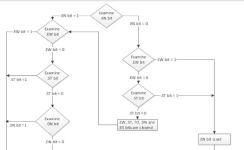TheWaterboy
Lifetime Supporting Member + Moderator
Using an L81 - I have the arrangement below that will try the Ethernet Radio first and if that fails use the Cellular Radio. The Failover works ... until the Cellular Radio fails a cycle. When it does the ER bit for the CELL radio NEVER clears. I can toggle it off in Logix and it will go merrily on its way again.
FYI the POLL bit stays true until all MSG to this RTU either DN or ER.
I have this set up on 3 RTUs after a main microwave link failure and I did it very late at night as an emergency workaround expecting to find stupidity when I returned to it. But even in the fresh light of a new day I can't imagine why this is happening.
The Flowchart for the MSG instruction says that when the rung transitions true one of the things it does if the EN bit is not already set is to clear the ER bit. In my code an ER bit means move on to the next radio in the cycle so the rung will not be true for more than one scan. I thought that might be related so I added a delay to that process and it didn't change this behavoir.
Next I added a 500ms timer to reset the ER bit and that "fixes" it but why would it not reset on every new poll cycle in the same manner that the upper one does?

FYI the POLL bit stays true until all MSG to this RTU either DN or ER.
I have this set up on 3 RTUs after a main microwave link failure and I did it very late at night as an emergency workaround expecting to find stupidity when I returned to it. But even in the fresh light of a new day I can't imagine why this is happening.
The Flowchart for the MSG instruction says that when the rung transitions true one of the things it does if the EN bit is not already set is to clear the ER bit. In my code an ER bit means move on to the next radio in the cycle so the rung will not be true for more than one scan. I thought that might be related so I added a delay to that process and it didn't change this behavoir.
Next I added a 500ms timer to reset the ER bit and that "fixes" it but why would it not reset on every new poll cycle in the same manner that the upper one does?





